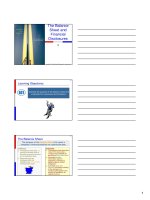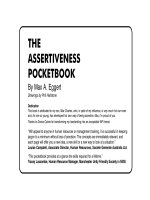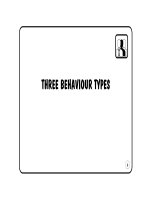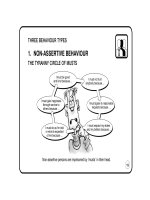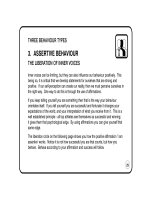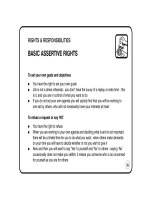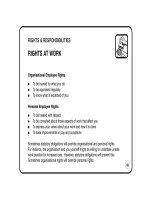THE BALANCE SHEET POCKET BOOK phần 9 potx
Bạn đang xem bản rút gọn của tài liệu. Xem và tải ngay bản đầy đủ của tài liệu tại đây (74.36 KB, 11 trang )
PROFIT AND LOSS ACCOUNT
COST OF GOODS SOLD
● Assume the company has a Finished Goods stock at the start of the period of £260k
● During the period £920k of completed products are transferred from production
● At the end of the period, if nothing had been sold, there would be £1,180k stock
of Finished Goods
● However, when the closing stock is valued there is found to be only £180k in stock
● Hence, by difference, the value of stock shipped from Finished Goods,
ie: the Cost of Goods Sold - must be £1,000k
87
PROFIT AND LOSS ACCOUNT
COMMON MISCONCEPTIONS
‘If I compare the results of two businesses, the one which has made more profit
has done better.’
Not necessarily. What matters is not profit but profitability, ie: how much profit has been
made on every £1 invested in the business. After all, if evaluating the opportunity to
invest in a project offering a profit of £1,000 the first question would be: `How much
has to be invested in order to make the £1,000 profit?’ Company performance is
measured on this basis using the Return on Capital Employed (ROCE)
Operating Profit
ROCE = x 100
Net Capital Employed
Note
● Operating Profit is used as being the lowest level in the Profit and Loss Account
over which operational management has control p81
● Net Capital Employed = Source of Funds p61
88
PROFIT AND LOSS ACCOUNT
COMMON MISCONCEPTIONS
EXAMPLE
Compare the performance of companies X and Y:
Operating Profit Net Capital Employed ROCE
£m £m %
X 10 25 40
Y 100 400 25
Hence, although Y makes 10 times more operating profit than X, X is the better
investment as it generates 40p per £1 long-term finance compared with Y’s 25p.
89
PROFIT AND LOSS ACCOUNT
PUBLISHED FORMAT
The Profit and Loss Account
Published Format
A Report to the Business Owners
the Shareholders
90
PROFIT AND LOSS ACCOUNT
PUBLISHED FORMAT
● This report to the Shareholders is published and consequently is available
to the competitors
Consider the dilemma:
- provide information to inform the Owners
- competitors use published information
● Therefore the practice tends to be to provide the legal minimum in terms of
specific numbers and to provide business statements and pictures to support
the numbers shown (eg: the Directors’ Report)
● Key items of Revenue Expenditure are given in the Notes to the Accounts, eg:
- Payroll Costs; Payroll Expenses; Social Security Costs; Depreciation;
Charitable Donations; Political Contributions, etc
91
PROFIT AND LOSS ACCOUNT
PUBLISHED FORMAT
● At first glance the format may not look
dissimilar to the internal management format
● Preceding years’ figures are required
to be shown
● Figures shown are totals only - some
analysis will be available in the
Notes to the Accounts
● In large companies/groups it will be difficult,
if not impossible, to break down the figures -
by product, customer or business units
● The Published Statement is subject to audit
(Note: Special rules apply for small companies)
92
Profit and Loss Account
for the 12 months ended
£’000
Turnover 1600
Less: Operating Costs 1400
Profit before
Interest and Tax 200
Less: Interest 33
Profit before Tax 167
Less: Tax 57
Earnings 110
Less: Dividend 30
Retained Profits 80
APPENDIX ONE
JARGON EXPLAINED
93
NB
APPENDIX ONE
JARGON EXPLAINED
Page
Amortisation: See Depreciation
Attributable The Revenue Expenditure associated with producing 27
Cost: and delivering the products sold during the period
Balance Sheet: A financial statement showing, at a point in time, where 46
the money came from (Net Capital Employed) and
how it is currently invested (Net Assets Employed)
Bottom Line: See Operating Profit 81
Capital All expenditure related to the purchase or improvement 37
Expenditure: of Facilities/Processes (Fixed Assets)
Cost of The Product Cost of those goods sold during the period 80
Goods Sold: (also known as Cost of Sales)
Current Cash or other assets which are converted into cash in 21
Assets: the normal course of trading, eg: Stock, Debtors
94
NB
APPENDIX ONE
JARGON EXPLAINED
Page
Current Amounts due to other parties (eg: suppliers, banks) within 22
Liabilities: the short-term (usually 12 months)
Creditors: The amount of money the company owes its suppliers 22
(also referred to as Payables)
Debtors: The sum owed to the business by its customers 22
(also referred to as Receivables)
Depreciation: A method of charging out the cost of Fixed Assets to those 29
periods benefiting from the assets’ use
Dividend: The part of Earnings paid out to the Shareholders in order 30
to give them an income on their investment
Earnings: The profits left for the Shareholders once all the business 30
costs (including Interest and Ta x) have been met. Some
will be paid out as Dividend, the rest reinvested
within the business - Retained Profit
95
NB
APPENDIX ONE
JARGON EXPLAINED
Page
Fixed Asset: Facilities or Processes providing the infrastructure of the 19
business. These are purchased for use within the
business rather than for purposes of re-sale
Gross Profit: Sales less Cost of Goods Sold 80
Interest: Lenders will expect a return on their investment in the 30
form of interest
Inventory: See Stock
Loan Capital: Long Term investment in the business in the form of a loan 13
Net Assets The accountant’s expression for `Use of Funds’, 61
Employed: ie: Fixed Assets and Working Capital
Net Book Fixed Assets are valued at Net Book Value in the Balance 46
Value: Sheet, being Cost less Depreciation
96
NB
APPENDIX ONE
JARGON EXPLAINED
Page
Net Capital The accountant’s expression for `Source of Funds’, 61
Employed: ie: Net Worth and Loan Capital
Net Profit: See Operating Profit
Net Worth: See Shareholders’ Funds
Operating A measure of local operating performance. This is the profit 78
Profit: after all operating costs (product-related and expenses)
have been considered, but before financing costs,
eg: Interest, Tax and Dividend
Operating
Statement: See Profit and Loss Account
Payables: See Creditors
Product This will depend on the company’s costing system but will 80
Cost: typically include the cost of material, shopfloor labour and
associated manufacturing expenses
97
NB
